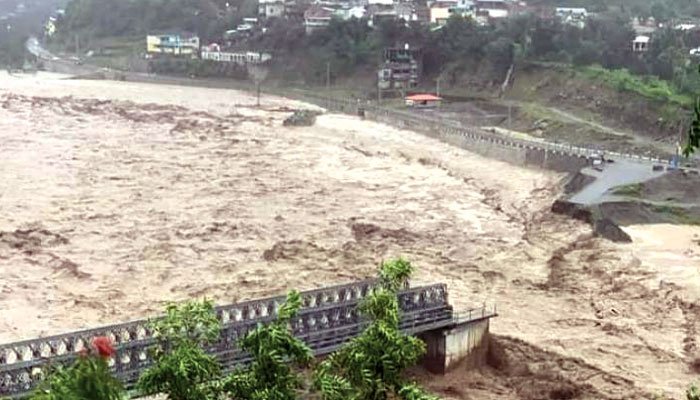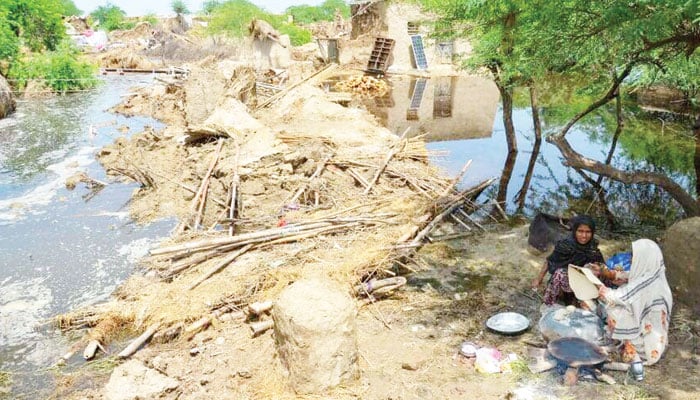Unfortunately, the recent floods in Pakistan have caused irreparable damage, especially in Balochistan and Sindh, the condition is very bad. Hundreds of people lost their lives, thousands of people became homeless and helpless. Livestock, houses, farms, lands, everything has been destroyed. Years of hard work and years of planning have been completely destroyed. The continuous rains in two months have destroyed and destroyed many things.
Pakistan was already suffering from an economic crisis. The onslaught of this natural disaster from above created many other threats, including loss of human life, damage to buildings and infrastructure, loss of crops and livestock, landslides, human health. Dangers, disruption of transport and communication etc.
According to a conservative estimate, the damage caused by rains in 1989 and 2016 was around 108 million and the current rains have doubled this rate. The damage estimate is many times higher. Due to severe damage, Sindh has been declared a disaster. As a result of this devastating heat wave, the wheat crop, cotton, vegetables and many other basic agricultural commodities have been completely destroyed in Sindh along with the monsoon rains across Pakistan, but the standing crops are facing further damage until harvest. can be These heavy rains have not only weakened the crops physically, but they can also delay the planting and harvesting of the new crop.
Excess water inhibits root growth and reduces oxygen supply, as well as affecting nutrient uptake. Agriculture in Pakistan is dependent on rain or snowmelt water. Unfortunately, the water received for the past few years was insufficient for the country’s agricultural needs, which led to a drought and now this torrential rain. Instead of stabilizing the agricultural structure, it led to its complete destruction.
According to the Economic Survey of Pakistan, the production target in Sindh in 2021-22 is 22.7 per capita while in 2020-21 it was up to 23 percent. This was despite the sector growing at 4.4 per cent in 2021-22 from 3.5 per cent in 2020-21. The share of agriculture in Pakistan’s GDP has been steadily declining over the years, with the recent floods falling short of the target.
Thousands of acres of land are now unproductive. The data for 2020-2021 shows that the area used for agriculture in Sindh is decreasing significantly, due to which the province is a degraded state. We are facing a situation where we have to depend on other regions to meet our local needs, as a result of which food grains have to be bought at double prices from the market, this is the reason why the economic deterioration is increasing day by day. Is.
From mid-June 2022, the heaviest monsoon rains began across Pakistan, due to which the country faced the worst floods in a decade. According to the National Disaster Management Authority of Pakistan, more than 33 million people were affected by the floods. More than 1,100 houses were destroyed while more than 1,100 people were killed in the flood relay. Almost a vast area was under water and the situation is still worse in many areas. According to Relief Web, about 150 bridges across the country. And 3,500 kilometers and 2,200 miles of roads have been destroyed, while more than 7 lakh cattle and 20 lakh acres of crops and gardens have also been completely destroyed. Immense volumes of rain and meltwater have inundated the reservoir canals of the country’s large and highly developed system of irrigation dams. Due to the continuous melting of glaciers in Pakistan, the impact and duration of monsoon rains has increased.
This is the reason that after the rain, many types of insects including insects come out of their burrows and appear on the ground. Firstly, the underground habitats of many insects were destroyed. Therefore, they resort to the upper surface for shelter. Secondly, many insects thrive in hot, humid environments. So the best time to breed them is when they reach the upper stage where they go through all the stages of sexual reproduction and breeding.

They lay eggs in rainy season. A sudden increase in the population of insects also leads to the spread of many deadly diseases. These include viral fever, cholera, malaria, dengue, eye infection, rash, gastrointestinal problems, colds, flu and swine etc. Insects directly play a key role in spreading all these diseases. Here, instead of many insects, only small insects are being mentioned, which are abundant in the rainy season and also play a special role in spreading many deadly diseases. Usually every other person is affected by their attack and infection. The top among these insects is (Fire Ants).
Both males and females become flightless during this season, as the temperature during the rainy season ranges from 75.2 to 89.9 °F with a relative humidity of 80 percent, and these two favorable conditions usually occur during the monsoon rains. are available. While in the second group of insects, the Flying Termite, which is known as the flying termite, is a termite that is very deadly and destructive to wood and paper products from day one. Unfortunately, their destruction is so common in many countries. And it is dangerous that many insurance companies do not accept termite damage claims in their policies. Termites come out in large numbers after continuous rain.
They generally follow the same behavior as chinotians, except that ants tend to move to brightly lit areas and are more active there, while termites prefer cool, moist, relatively shaded areas. After that, another insect which is (floating ants) is floating ants. It is also familiar with the wealth of intellect and consciousness. When the rains are falling continuously and the flow of water is fast, then these lowly creatures form a group together to form a raft.
Thousands of ants band together to float on dangerous water waves with each other’s support. And they float to a safe place. In this way the queen ant easily manages to lead her colony, eggs and other ants to a safe place by mutually swimming through the water under her able leadership. It is the result of this unity that how a lowly creature is able to overcome the merciless waves of water and save itself and its posterity from danger through unity.
According to the United States Environmental Protection Agency (EPA), cockroaches carry bacteria on food that can cause Salmonella staphylococcus and Staphylococcus aureus. According to the World Health Organization (WHO), cockroaches also play a key role as carriers of intestinal diseases such as dysentery, diarrhoea, cholera and typhoid fever. According to the National Institute of Environmental Health Sciences, there are thousands of species of cockroaches, while 30 species are considered dangerous/lethal.
These creatures are found almost everywhere on the planet. Except for Antarctica, where a review of the fossil record shows its presence in fossils that are about 350 million years old. You can reduce and control cockroach populations without the help of professionals by limiting their access to water and food and shelter, and sealing entry points such as cracks in floors and walls. Rain is just as effective for mosquito breeding as spring is for flower breeding. find
Anomalus lava thrives in stagnant water, such as rainwater, roof ditches, old tires, small streams, small cracks, irrigation reservoirs in agricultural land, which are usually sources that mosquitoes use for breeding and breeding. The rains increase these reservoirs as much as possible, a special type of mosquito including Adesian ilminae that lives on clean and fresh water and their larvae are usually found in cages or air conditioner units. There are some points to keep in mind to prevent mosquito breeding. Accumulated water reservoirs should be destroyed, they should not be allowed to fill with water.
With the continuation of the recent rains, where the mosquito population has increased, many areas in the country are prone to mosquito-borne diseases, including malaria, dengue, Zika virus, West Nine virus, dengue and malaria. It is usually spread by mosquito bites. Dengue rates have been very high in areas affected by recent floods. Dengue is primarily transmitted by the Aedes algalitae mosquito. Found in over 100 countries.
Dengue is the most common vector-borne viral disease in the world, causing 50 to 100 million infections/cases and approximately 25,000 deaths globally each year. After dengue, malaria is also a dangerous and common infectious disease caused by the Pulis modem parasite. The pathogen is spread by bites on Anopheles mosquitoes. About 220 million cases are reported worldwide annually and the death rate is close to 500,000 and more than 400,000.
Centipedes These long and dangerous creatures also come out after rain. Generally, their breeding period is slow and is not directly affected by rainfall, however, after the destruction of the underground habitat, they appear on the upper surface, and another important reason is their predatory nature, since the rainy season. It is full of insects and the abundant availability of these small insects also attracts centipedes, so they move to the open air to fulfill their nutritional needs and eat insects.
All centipedes release a special type of venom to capture their prey. Centipede bites rarely cause health complications in humans and are usually not dangerous or fatal, although some centipedes It contains deadly venom that produces different types of toxins. including histamine, serotonin, and cardiotoxic toxins leading to S. The WoodLous or Soco Bug is a creature known by many names, including the Bully Buck, Doodle Bug, Hennerbug, PolyPoly and Chuggy Bug, etc. It likes to live in wet and cool places.
Their growth increases considerably in the rainy season. They live in domestic soil and are generally not lethal or dangerous to humans, but their presence causes considerable damage to plants. Their presence is also indicative of their large numbers underground. They gradually weaken the plant’s roots, causing the plant to become stunted and wilt within days. Ticks and Fleas Ticks are known active parasites of pets and other animals.
Its infection rate increases during the rainy season and every third animal is found to be a victim. They usually thrive in humid environments and find their prey and torment it for weeks. Unfortunately, many valuable and nadu-nayan breeds of cattle fall into it and thus almost lose their market value.
The population of housefly is also higher in rainy season. Like other insects, they like humid places. An increase is seen due to humidity and outdoor dirt, but the housefly is also responsible for transmitting about 65 diseases to humans, including typhoid, fever, cholera, polio, anthrax, tulmea, measles and tuberculosis. Usually these flies play the role of a carrier in spreading many deadly diseases.
The mortgage beetle is also a robust oval black creature, as the name suggests, they are exclusively outdoors in shrubs. Generally, their larvae are underground and as the soil softens after rain, it They come to the surface for their own protection. They are not considered very dangerous to humans. ADVERTISE MITE Although red velvet mites are called arachnids, they also come out during the rainy season to breed and feed like other insects. They are very small in size and attach to other insects. They make it easier to get their education and food.
Their prey insects include locusts and grasshoppers, and they also cause the spread of many deadly diseases in association with other insects. Rain Molth This is a very strange insect. It usually does not prefer its own food and drink. They emerge from their pupa in large numbers after rain and live only for 24 hours after emergence. During this time, these huts perform important activities. Along with all these insects, among other insects, dragflies and dam flies are also frequently seen after the rains.
setTimeout(function(){
!function(f,b,e,v,n,t,s)
{if(f.fbq)return;n=f.fbq=function(){n.callMethod?
n.callMethod.apply(n,arguments):n.queue.push(arguments)};
if(!f._fbq)f._fbq=n;n.push=n;n.loaded=!0;n.version=’2.0′;
n.queue=[];t=b.createElement(e);t.async=!0;
t.src=v;s=b.getElementsByTagName(e)[0];
s.parentNode.insertBefore(t,s)}(window,document,’script’,
‘https://connect.facebook.net/en_US/fbevents.js’);
fbq(‘init’, ‘836181349842357’);
fbq(‘track’, ‘PageView’);
}, 6000);
/*setTimeout(function(){
(function (d, s, id) {
var js, fjs = d.getElementsByTagName(s)[0];
if (d.getElementById(id)) return;
js = d.createElement(s);
js.id = id;
js.src = “//connect.facebook.net/en_US/sdk.js#xfbml=1&version=v2.11&appId=580305968816694”;
fjs.parentNode.insertBefore(js, fjs);
}(document, ‘script’, ‘facebook-jssdk’));
}, 4000);*/


